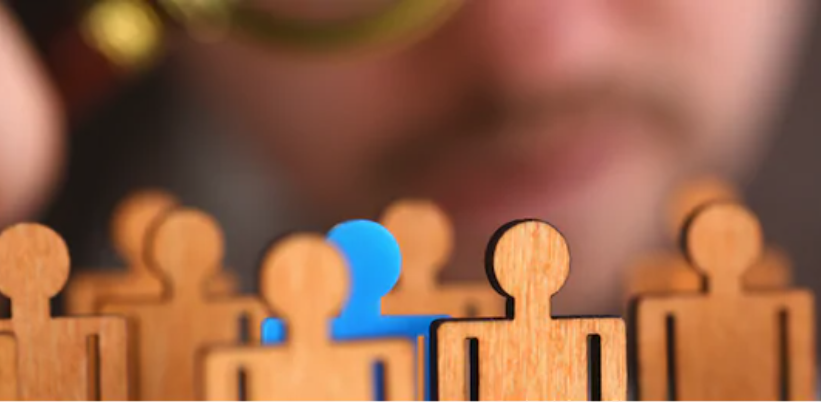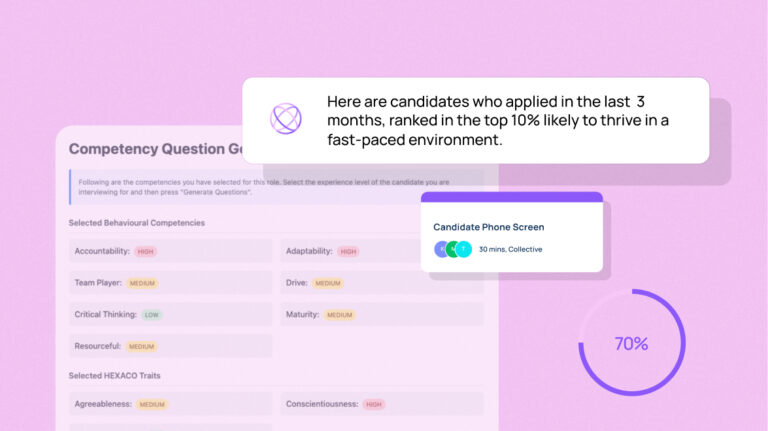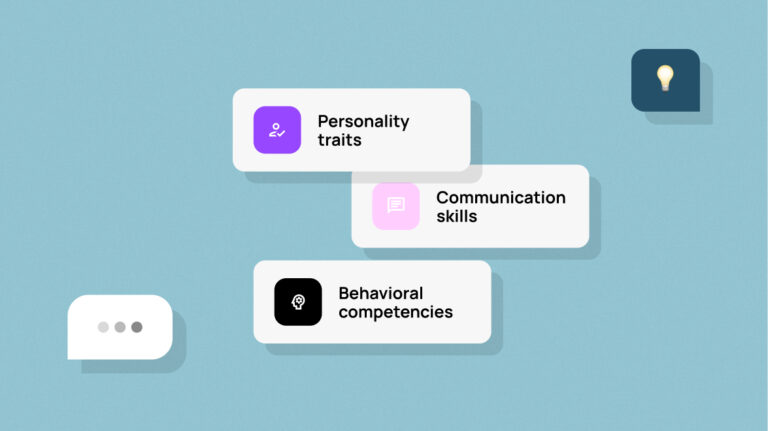Talent assessment tools: How to manage hiring, Uses

In recent years, a flood of pre-employment talent assessment tools has come into the market.
TL;DR:
-
Talent assessment tools help recruiters look beyond CVs to verify skills, behaviours and potential, speeding confident, data-driven hiring.
-
Benefits: higher recruiter productivity, lower cost per hire, faster time to fill, deeper talent pools, stronger diversity via bias-reduced screening, and better candidate experience (including personalised feedback).
-
Three assessment buckets: learned knowledge/skills/experience, work behaviours via simulations/work samples, and innate attributes (personality, cognitive ability, learning agility).
-
Common tools: job knowledge and coding tests, general skills (literacy/numeracy), work samples and job simulations, cognitive screening, integrity and psychographic assessments, automated interviews, and AI-driven candidate ranking.
-
Best fit comes from mapping tools directly to role competencies and validated criteria; avoid vague proxies like “culture fit.”
-
Blind, text-based interviews (e.g., Sapia) remove visual cues and CV pedigree to reduce unconscious bias while improving fairness at the screening stage.
-
Integrate tools with your ATS/CRM so data flows, reports combine easily, and stakeholders share one source of truth.
-
Candidate experience matters: keep assessments relevant, accessible, mobile-first, concise, and respectful — and capture candidate feedback.
-
Use objective scoring rubrics and evidence, then complement with structured interviews; tools should inform decisions, not replace human judgment.
-
10-item buyer checklist: define what you must measure, decide output depth (rankings vs analysis), align with brand and DE&I, ensure bias mitigation, support interviews, verify integrations, consider candidate perception, research proofs/demos, model ROI, and uphold best-practice ethics.
-
Governance: monitor for adverse impact, validate content/face/predictive validity, and keep audit trails to meet compliance and ethics standards.
-
Bottom line: the right, integrated mix of assessments + structured interviewing delivers better quality-of-hire, stronger retention and a fairer process at scale.
From automating initial candidate interviews to conducting online skills or personality testing, these tools help recruiters look beyond the CV to find the best candidates for every job.
In today’s competitive world of work, recruiters and hiring managers want to be sure that every decision is the right decision. As competition between companies for the very best talent has increased and as more candidates apply for fewer roles, just filling a role is no longer an option. Reviewing CVs and assessing candidates is time-consuming and costly, and recruiters need to be confident that they are delivering value to their clients in both costs and the quality of candidates.
That’s why recruiters and employers alike are seeking ways to take the guesswork out of the process in identifying talent who will be the best fit for the team, work most productively and stay in the role longer.
In this guide, Sapia explores the types of tools available, the insights they can provide and how they can benefit your business. We’ll also provide some guidelines for helping you to assess which tools could deliver the best return on your investment.
Why use talent assessment tools?
Pre-employment assessment of candidates is, of course, the very reason that recruiters exist.
Talent assessment tools have been developed to help make that process easier, faster and more cost-effective. The tools leverage technology to more accurately identify the best talent for a role and predict their fit and performance in that organisation.
The benefits of candidate evaluation software can include:
- Go beyond the CV – Leverage technology to focus on skills as well as things such as cultural fit, aptitude, cognitive abilities and more to identify candidates “most likely” to be successful.
- Increase productivity – Spend less time on manual screening and more time on higher-value briefs and candidates.
- Decrease costs – Automated processes can reduce the costs of manual talent review and assessment, dramatically reducing overall hiring costs. Redirect savings to investments in people or technology.
- Remove bias from the process – Data-driven tools can take unconscious bias out of the assessment equation to focus on skills and fit. Sapia’s Ai-enabled text interview automation platform, for example, offers blind screening at its best to help build workplace diversity.
- Build deeper talent pools – Use technology to extend your reach to more candidates. The best tools integrate with your applicant tracking system to seamlessly run hiring processes and build ‘ready to go’ talent capabilities.
- Fill roles faster – With the ability to screen more candidates in less time you can confidently begin interviewing sooner.
- Be successful – With the right talent assessment tools working for your business, you are more likely to achieve the best talent outcomes every time.
- Improve the candidate experience – Provide an engaging and enjoyable experience for candidates. Some tools including Sapia’s platform automate personalised feedback that is always appreciated by candidates.
- Know what candidates want – Using data to understand candidates, their motivations and their expectations can help managers be better prepared for onboarding. Building profiles of successful candidates will also provide insight for the next similar brief.
- Make hiring decisions with confidence – Objective evidence and data-driven findings can help make every decision a better decision.
Types of talent assessment tools
The wide range of available talent assessment tools can be generally grouped into three areas of assessment: Work behaviours; Knowledge, skills and experience; Innate abilities and attributes.
Some tools may focus on a single attribute such as coding abilities or English competency while others can combine a range of tests and interview capabilities within one platform.
Once the requirements of a role are understood, the right tools can be chosen to assess those competencies.
1. Learnt knowledge, skills and experience assessments look at candidates’ specific job knowledge, qualifications and work experience. Assessed against the agreed capabilities required for the role, these assessments can be an extremely accurate and effective predictor of a candidate’s performance in the role. Some tools may focus on specific sectors and roles – eg sales, HR, health, hospitality, programming, engineering – while other platforms will cover a range of these with tests that can be customised to specific requirements
Some examples:
- Job knowledge assessments: This type of test measures specific areas of knowledge or skills – often technical – that are considered minimum requirements for a role.
- Skills assessments: Through mobile-driven text conversations, video interviews, multiple-choice quizzes or even online ‘games’, job-specific and general work skills or soft skills can be assessed.
- Coding assessments: There are many tools designed specifically to test and assess candidates’ coding abilities and technical skills. These assessments can be used at the screening stage to filter candidates or during later interview stages where full-scale coding challenges could reflect actual work or challenges the candidate would encounter as an employee. Tools can be a platform and industry-specific.
- General skills: Tools can also address general work skills such as literacy and numeracy, basic typing and data entry, ability to follow instructions, and more.
- Work behaviour assessments: observe actual behaviours and simulations that match and help predict real on-the-job requirements. Job simulation exercises and work sample tests give candidates an opportunity to demonstrate their abilities and skills. They allow employers to assess job-specific skills and analyse candidates’ capabilities in decision-making and prioritising, multi-tasking or their ability to work under pressure. Tasks can be highly customised to specific responsibilities of the role and of the organisation.
2. Innate abilities and attributes assessments focus on traits that are not job-specific such as personality, interests and cognitive abilities including problem-solving, logic skills, reading comprehension and learning ability. These universal human traits have proven to be effective indicators of job performance and cultural fit. Softskill testing: Tools can be used for talent evaluation across a range of qualities and personality traits such as teamwork, sales ability, good judgement, integrity, curiosity, impact, ownership and independence.
Some examples:
- Automated Interviews: AI-driven platforms can automate interview processes and provide a better experience for recruiters, hirers and candidates alike. Platforms like Sapia’s automated text interview can provide a true advantage, especially at the screening stage for large volume recruitment briefs such as customer-facing retail or service teams.
- Candidate ranking: Powered by artificial intelligence and machine learning, many assessment tools will analyse results to grade and rank candidates. Rankings around different criteria can save time and provide the confidence that you are focused on the right candidates.
- Cognitive screening: These tools provide insight into how candidates think, solve problems and learn. Insights can help hirers understand future management needs to prepare and support new employees to be successful in their role.
- Integrity assessments: Assessing attitudes and experiences relating to honesty, reliability and trust.
- Psychographic screening: Insights into a candidate’s personality, values and interests can help assess their fit within a team and within an organisation’s culture and values.
- Bias-free screening: Unconscious bias removed from the process so candidates are assessed on their skills and decisions are not influenced by a candidate’s gender, age, ethnicity and other personal credentials that do not affect their ability to do the job. Sapia’s mobile-first, text interview platform is an industry leader in blind interviewing.
10 questions to help you choose the best talent assessment tools
Saving time and money, filling roles with better quality candidates. That’s the key reason talent assessment tools are indispensable across the recruitment industry and in every employment sector. But with the plethora of tools available, how do you decide which ones are right for your organisation? Which talent assessment tools will best contribute to your success?
Before you invest, Sapia’s talent assessment tool checklist can help:
1) What do you need to know?
As an experienced recruiter, you can probably already recognise where your talent assessments sometimes fall short or you think they could be better. The data insight that can support your recruitment and hiring processes will be different for everyone and will vary according to:
- industry or sector specialisation
- experience level of candidates – entry-level to management and C-suite roles
- qualifications, skills or personality traits required for roles
- nature of brief– specialist technical roles or large volume team roles
When you know what you need to measure, you can start narrowing your search to identify the tools that can give you what you’re looking for.
2) How will the findings be presented?
Consider the format and depth of the feedback that different tools can provide. Is a numerical ranking of candidates sufficient or will in-depth analysis, comparisons and recommendations better serve your needs?
3) Do assessments support the hiring organisation’s brand values and strategy?
Consider whether the tools positively support an organisation’s employment policies and practices such as workplace diversity and inclusion, language or numeric competencies and minimum skills requirements.
4) Do tools remove bias from talent assessment?
Removing unconscious bias from the talent assessment process is a priority for organisations looking to improve workplace diversity and inclusion. While a text-based chat platform (such as Sapia) can effectively take bias out of the equation, video submissions bring the opportunity for bias front and centre of the process.
5) Do the tools support the interview process?
Few, if any, hiring decisions should ever be made solely on the basis of talent assessment tools rankings or findings. Make sure tools can provide meaningful data that will enhance the interview process. Many tools will help identify areas that should be explored further in the interview process and even suggest questions to help shape the interview.
6) How will the tool integrate with existing systems?
The best tools will integrate with your existing systems and processes and with other tools. You want to be sure that you can combine data from different tools to create meaningful reports and records. Tools that integrate with your existing ATS (Applicant Tracking System) are likely to deliver the best savings in time and effort.
7) What will candidates think?
Every candidate deserves a fair and positive experience, whether they are successful or not. Choose tools that are easy and engaging to use, appropriate for the role and tools that will enhance, not undermine, your employer brand.
The best tools also deliver value by allowing candidates to provide feedback on their engagement with tools after the assessment process.
https://sapia.ai/blog/predictivehire-is-named-candidate-experience-solution-of-the-year/
8) How do I find out what tools are best?
Ask your industry colleagues for recommendations and search the web for reviews and guides like this one that can help you navigate a very crowded market. When you think you’ve found the tools that will work best for you, your clients and your candidates, ask vendors to show you how their assessment tools can deliver with a personal demonstration or even a free trial.
9) Have you analysed the costs?
You want to be sure that your investment will pay its way. Take the time to consider the value of the candidate feedback or assessment of different tools will provide. Many vendors provide online calculators to help you estimate the return on your investment.
10) Do the tools support best practice?
Talent assessment tools can provide objective, measurable insights that other more traditional recruitment methods can’t provide. But technology has its limits too. Make sure that a positive candidate experience remains a priority – nobody wants to feel discriminated against or feel embarrassed or violated by intrusive personality testing.
Make sure also that in focusing on one key skill or trait, you’re not missing a candidate’s true strengths. In short, don’t use your talent assessment tools as the recruitment tool, use them in conjunction with all the other methods, tools and skills in your recruitment toolbox.
The Buyers Guide to Navigating Ai Hiring Solutions
Leveraging objective data to augment decisions like who to hire and who to promote is critical if you are looking to minimise unconscious preferences and biases, which can surface even when those responsible have the best of intentions.
The greatest algorithm on earth is the one inside of our skull, but it is heavily biased. Human decision making is the ultimate black box.
Only with data, the right data alongside human judgment can we get any change happening. And clearly, what your employees and candidates are now looking for, is change. We hope that the debate over the value of diverse teams is now over. There is plenty of evidence that diverse teams lead to better decisions and therefore, business outcomes for any organisation.
This means that CHROs today are being charged with interrupting the bias in their people decisions and expected to manage bias as closely as the CFO manages the financials. But the use of Ai tools in hiring and promotion requires careful consideration to ensure the technology does not inadvertently introduce bias or amplify any existing biases. To assist HR decision-makers to navigate these decisions confidently, we invite you to consider these 8 critical questions when selecting your Ai technology. You will find not only the key questions to ask when testing the tools but why these are critical questions to ask and how to differentiate between the answers you are given.
This guide is presented by Sapia whose AI-powered, text chat talent assessment tool has a user satisfaction rate of 99%.


